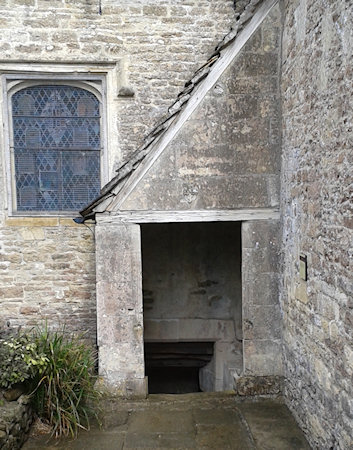
When I first arrived in the UK, my fascination with history took me to more than a few ruined castles. It seems I still have not had my fill. Every one of them has some gem that makes it special.
Last weekend we found ourselves in the neighbourhood of Farleigh Hungerford Castle, set in a lovely valley on the Somerset/Wiltshire border.
Despite the rain, it was lovely, with spectacular chapel and crypt. In this case, though… there was a certain Ewww factor.
Some time before 1383, Sir Thomas Hungerford began building himself a castle. Nine generations of Hungerfords lived there amid no end of family scandals, murders and intrigue. The castle was twice confiscated by the crown. It was a hotbed of Royalist / Parliamentarian anger during the Civil War. Bits were lost in wagers and it was finally destroyed, its stone used by locals to builds their homes and barns. Even its preservation was surrounded in controversy.
So – pretty much a standard history for an English Castle.
What is so special about this castle is the chapel – in both a good and a bad way.

The chapel was built around the 1370s as a village church, but was enclosed as part of the castle expansion in the mid-15th century.
Chapels of course, always have tombs. At the foot on the entry stairs is the tomb of a young priest employed to pray for the Hungerfords around the 1500s. His skeleton is said to have ‘near perfect teeth’. He must have died quite young for his teeth not to have decayed.
The walls of the chapel have wonderful wall paintings – some of which date back to the early 1400s. Sadly a misguided attempt to preserve St George by covering him in hot wax in the early 20th century has stained that part of the wall red. But the painting survives.

The paint also survives on some of the Hungerford family graves. I still wonder at how colourful so many chapels and churches must once have been.

There are several gruesome stories surrounding the Lords and Ladies who now lie in the chapel – a wife who burned her first husband to be free to marry again. A wife kept locked in the Lady Tower by her husband. He was later executed for witchcraft and homosexuality while she was freed and remarried.

But – the best (or worst) was waiting for us under the chapel.

The crypt contains several human shaped lead coffins- the finest examples of their kind in Britain. The coffins still hold the embalmed remains of four men, two women and two children.

The coffins were originally enclosed in wood – but were badly damaged by 18th and 19th century visitors… some of whom poked sharped sticks through the lead to get to what lay within. They even (get ready here it comes) are said to have tasted the embalming liquid they found inside.
Eewww.

Despite that – or maybe because of wonderful stories the castle holds – I had a lovely time wandering around Farleigh Hungerford. The sun even came out for a while. If you are ever down that way, I do recommend it.


Comments
3 responses to “A castle with the Ewww factor”
What an amazing castle! I’d never heard of it and it will definitely go on my ‘want to see’ list. I loved the vivid colours on the tomb, something I don’t think I’ve seen before.
The painting in the chapel was quite remarkable. There were coats of arms on the walls, and even cherubs (I think they were cherubs) on the timbers supporting the roof. It is well worth a look next time you are down that way.
Janet.
I used to live near Farleigh Hungerford Castle and loved visiting. I didn’t know the story about the crypt though. Ewww indeed! That’s taking curiosity too far!